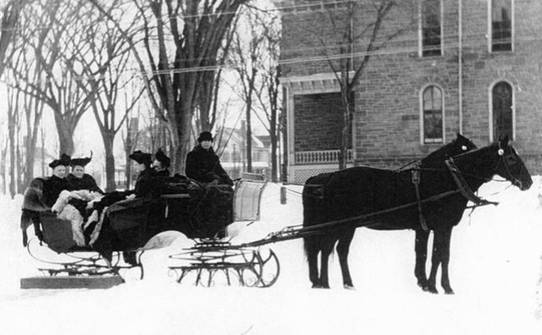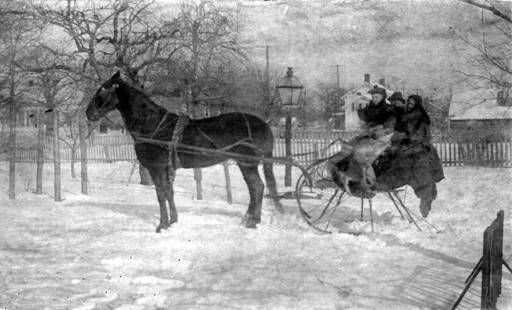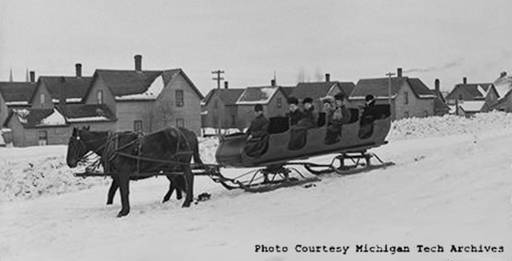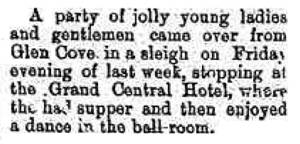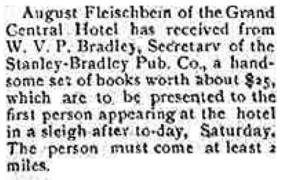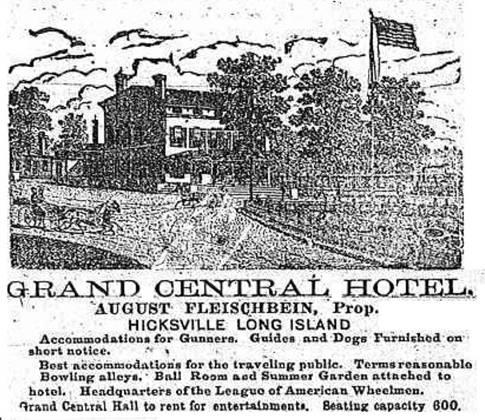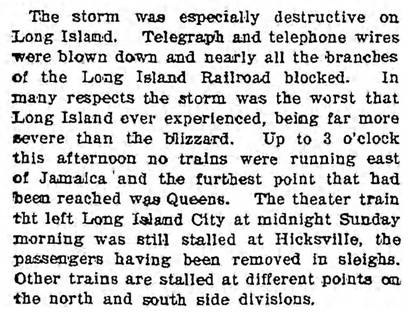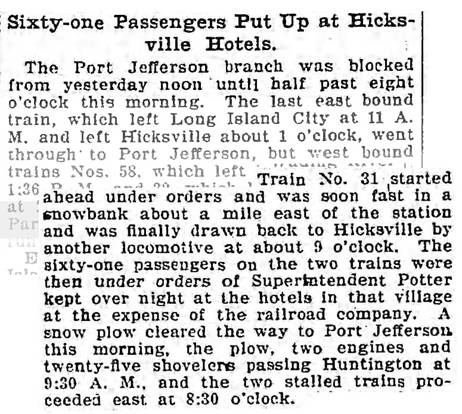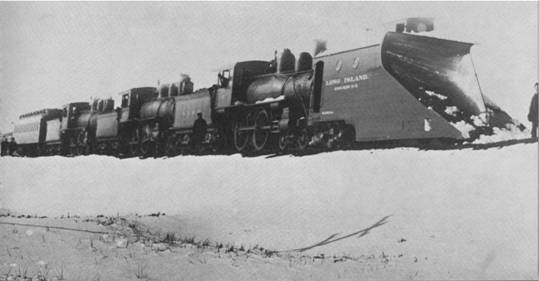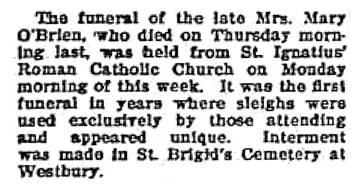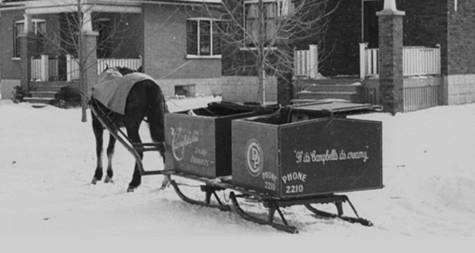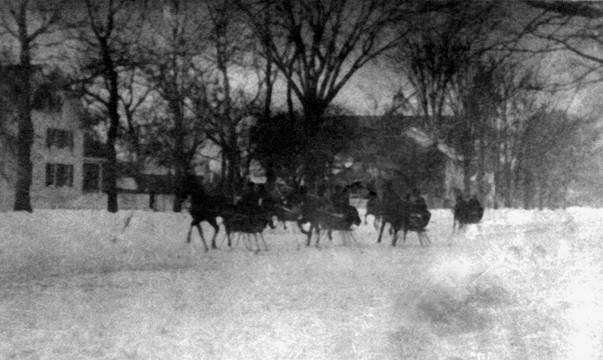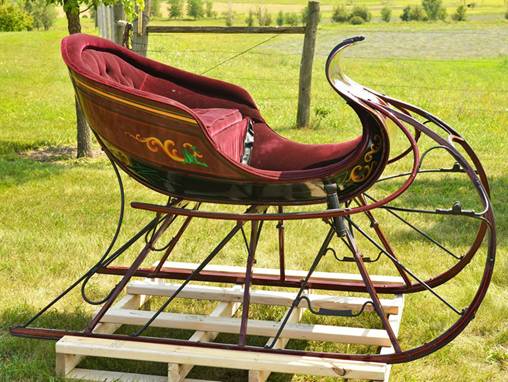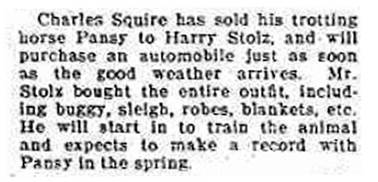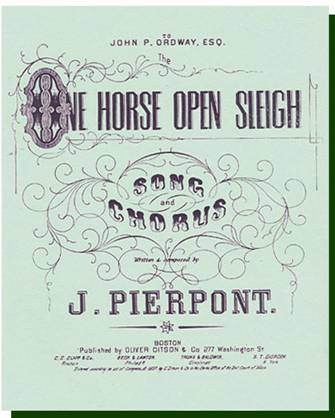|
DECEMBER 2018
A couple glides through an endless snowscape, with no
sound but jingling sleigh bells, the rhythm punctuated now and then by a
horse's whinny or snort. It's
like a scene from a romantic movie - and yet, the Currier and Ives
lithograph shown above once would have fit During many winters around 1900, people on
Long Island can be a magnet for deep snowfalls (e.g.,
in the winter of 1960-1961, it got three falls deeper than 12"),
but the snow that "sticks" to the ground in From the 1880s through the 1920s, however, This photograph was taken in
Obviously, small sleighs like the one shown
above were good for personal transportation, such as going to church, or
visiting friends who lived across town.
Taxi drivers also might use them, say, to pick up fares at the
railroad station. Alternatively,
larger sleighs could be hired to transport groups of people.
*** For those who bundled up well, sleighriding
in cold fresh air was considered both healthy and fun.
Community organizations sponsored free sleigh rides for children.
Not surprisingly, the faculty of the An evening sleigh ride for two was a favorite form of dating (or
double-dating, if the sleigh had two bench seats).
You could just ride "to nowhere," or maybe you would go out
for dinner to a favorite romantic spot in another town, as when the
people in this news article came to
Sometimes, proprietors encouraged winter
sleigh travel by offering special incentives to attract people who did
not reside in
All three items above are from the *** A recurring problem during the "big
snow" years was the stranding of Long Island Railroad trains, often
because of immense snow drifts - 12 feet or more high - east of The following reports date from 1896 and
1902, respectively.
Both items above are from The When severe snowstorms surprised the East
Coast in the 1890s, the
*** Travelers were not the only people who
needed sleighs when deep snows fell.
This news item is from 1920.
Both items above are from the As can be inferred from the above news
item, when snows made roads impassable to wagons, retailers and express
companies delivered goods via sleigh.
According to the 1897 Sears
Roebuck and Co. Catalogue, farmers and businesses could order
runners and other sleigh hardware, so that they could make their own
vehicles similar to the one shown here, with capacities ranging from
3,000 to 8,000 pounds.
Things usually worked out well, but in
early 1926 an express driver's day went awry as he made a delivery on
Above item from the *** Mischievous little boys were not at all
necessary for things to go wrong: sleighing had inherent risks, and
carelessness proved fatal more than once. A sleigh full of people was top-heavy; on a
tight curve, it might roll over, and come crashing down upon its
occupants. Even when going
straight ahead, what looked like a smooth white route might conceal a
rock or fallen branch, sturdy enough to make the runners on one side of
a speeding sleigh bounce upward, and send people hurtling over the side.
Sleighs sometimes had problems crossing the LIRR tracks, and
would spill their passengers on the ground. Even
if everything else went well, horses could get startled by anything -
a child on a toboggan coming downhill towards the road ahead, or the
sound of an automobile horn - and then start galloping willy-nilly,
tipping over their sleighs before they broke free.
And, of course, a sleigh might be struck by another vehicle. During the winters of the glorious
snowfalls, the columns of The
Brooklyn Daily Eagle and the Long-Islander
often mentioned sleighing casualties.
In hindsight, today's reader might think
that sleigh-riders should have worn seatbelts, or at least used sleighs
with higher sides (or even roll bars), but such thinking was not part of
Victorian / Edwardian culture. Whether
people chose to use sleighs, or they had to use them, they simply
accepted them as they were. *** Notwithstanding the risks and the potential
carnage, sportsmen took great pride in racing their sleighs.
Newspapers reported on who had just bought a new sleigh, or whose
trotter or pacer was said to be the fastest horse in town.
Races, both spontaneous and pre-arranged, attracted admiring
spectators. Venues included
both quiet rural roads and main village streets.
The photo below shows a 1910 sleigh race in the heart of
Spontaneous races "for fun" could arise
between any vehicles on runners, regardless of their respective sizes
and the animals that pulled them. One
newspaper article mentioned a race between a work sleigh, pulled by a
large draft-horse (think Budweiser),
and a lightweight sleigh, pulled by a spirited carriage horse. For those who raced seriously, the standard
vehicle of choice was a two-seat, single-horse open sleigh, of a type
called a cutter.
I have yet to find a clear definition of what qualified a sleigh
as a cutter, other than perhaps its not being very heavy for its size.
To further confuse the issue, I also have seen references to a
type of sleigh known as a speeder, built just for racing, pictures of which so strongly
resemble a cutter that I cannot differentiate one from the other.
Whatever the classification(s) of the
sleighs, in organized races, the participating horses were either
trotters or pacers. These
two gaits persist today in harness racing, where they do not compete
against each other. While writing this article, I found myself
imagining American Graffiti in the
Snow - wise-cracking sleigh racers who cruised the main drags of
their towns, in search of pick-up races against new competition.
Above item from the (No, I have found no report of either Black
Bean or his competitors overturning a sleigh so that it careened off
the street and caught fire.) When a race materialized, the people along
Broadway in Hicksville (or The news item below announced the sale of a
well-known local trotter, Pansy,
to a
Above item from the ***
We've
all sung Jingle Bells in our
time, and we know what it's about, right?
Well, perhaps not; let's review some things. When
the song was first published in the 1850s, it was called The One Horse Open Sleigh. Over
the years, the original melody of the chorus has been dumbed-down a
little; notes were adjusted to make it easier for people, especially
children, to sing. You can
hear the original melody at https://www.youtube.com/watch?v=YR6YAgVIljg And
about those bells... they jingle, but we really should call them
"sleigh bells." Most
likely, the phrase "Jingle bells" was intended to mean "Ring,
sleigh bells!" with jingle
being used as a verb - an idea which jibes with the lyric "Jingle
all the way." Today,
though, people may mistakenly interpret the phrase "jingle bells" as
referring to a type of bell. What
is the song about? Obviously,
it has nothing whatsoever to do with Christmas or Santa Claus.
New Englander James Pierpont was the composer and lyricist (he
also happened to be a nephew of J. P. Morgan).
He wrote his sleighing song about the races he used to see in The
second verse - you can see the lyrics go by on the screen if you use
the link provided above - mentions that the horse got into a
snowdrift, upsetting the sleigh.
We might expect that the couple in the sleigh had been ejected
and injured. Since the song
keeps going, however, we can assume that the driver and his Miss Fannie
survived well enough. The
third verse refers to a race. The
narrator has landed on his back in the snow.
(Note that this sort of
thing often occurred during races. If
something startled a racing horse and it momentarily hesitated, the
front of the cutter would suddenly dip downward, throwing the driver
over the dash.) When the
fallen driver looks up, he sees a rival sleigh pass by, the driver
looking down at him and laughing at his misfortune.
Apparently, sleigh racing was rather cut-throat.
Who knew? The
fourth verse is racy, in more than one sense of the word.
The listener is urged to get himself some girls while he is still
young. All right, but how?
Well, one way is to win races, by hitching his open sleigh to a
horse that can do "2 40 as his speed."
Huh? In the 1850s, 2
minutes and 40 seconds was considered an excellent time for a
standardbred horse to trot a mile over smooth terrain. Today,
however, such a time would be quite poor.
Thanks to an additional 160 years of breeding, better diet,
better training methods, and improved sulkies, the record times for a
one-mile distance on the various sizes of racing ovals are now in the
1:49 to 1:51 range. No
matter. In 2018, it seems
almost impossible to meet a young woman who is attracted to men by the
speed of their trotters, or by the quaint way in which their sleighs can
throw a girl overboard into the snow.
Ah, the Good Old Days. Well, that's it for this month. ***
|
||||||||||||||||||||||||||||||||||||||||||||||||||||

